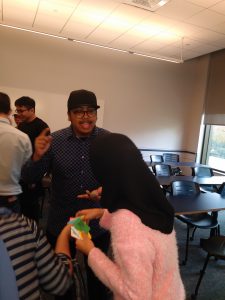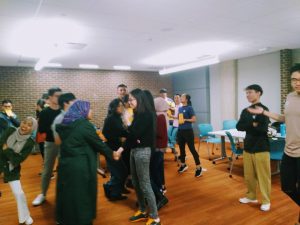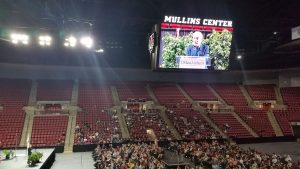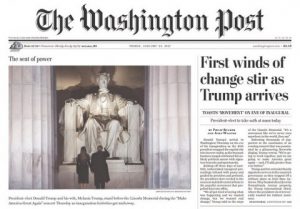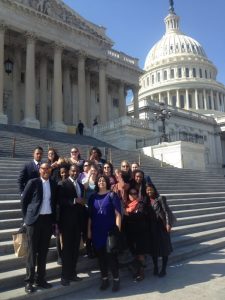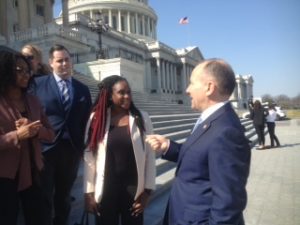Continuing our series in this blog on teaching human rights in Trump’s first 100 days in office this post explores the potential of using satire as a teaching and intellectual tool.
There is often a sad running joke made from teachers of human rights to their students: “this class might be interesting, but it will be downright depressing.” The gravity of the subject matter of rights violations along with stories of savagery, and despicable behavior by the powerful, often make for a suffocating and serious classroom environment. It is very easy to get caught in a dark tide of emotions from human rights content which is typically steeped in human suffering. This is compounded by the inability of the powerless to enforce rights laws globally, or the existence of effective legal mechanisms to consistently hold leaders accountable for abuses they perpetrate.
The problem of powerful elites/politicians ignoring rights law is as old as the laws themselves. Our response as teachers, and as students of human rights, to the lack of enforcement, at least for me, can range from frustration, anger, trepidation, sorrow, to even feeling a sense of hopelessness for the whole rights endeavor. Maybe there are alternative responses to teaching about how the powerful seem to always get away with abuses? Perhaps poking fun at those who violate rights can allow for some space to vent, express frustration/dissatisfaction, and promote a creative learning environment for our students? Could satire even prove effective at garnering the public and media’s attention to demand better government response to rights abuses?

Photo from anti-Trump rally in Northampton, MA following the election: Orange is the New Wack. Photo credit: the author of this blog.
In an experiment, I taught a mid-semester class that was slated on the syllabus to be devoted to freedom of expression/press yet instead of simply focusing on rights laws, enforcement or the lack thereof, I conceptualized the lesson through the lens of satire. Before describing my approach I should mention that this class was titled “Human Rights Through Film” (it was and upper level course but I think a lesson like this could work with an intro course as well). The class took place in the middle of the semester when we already knew each other, and as happenstance would have it, was just about two-months into Trump’s reign as President.
The Trump Administration assault on rights has been well documented—including on our blog. As seen in the first 100 days of his administration his record on rights leaves defenders of rights not knowing whether to laugh or cry. Clearly, humorous satire/parody has come hot and heavy aimed at Trump, from the personal parody portrayed by Alec Baldwin on SNL, to information driven takedowns by John Oliver, to the devastating satire aired nightly by Stephen Colbert on the Late Show. Determining any actual impact of comedic approaches is beyond the scope of this blog post (see this article for an exploration of its potential), yet investigating comedic approaches, limited to film, proves an interesting way to expose students to various abuses of rights, and especially freedom of expression, as comedians seem to always be pushing the limits and dodging defamation law.
In my lesson I had students watch at home, what is perhaps the preeminent political satire film of our time, Dr. Stranglove by Stanley Kubrick. I also had them read work by Lisa Colletta (full citation below) and during class we analyzed clips from SNL, Colbert, Egypt’s Bassem Youssef, and discussed Dr. Strangelove. Conceptually, I divided comedic approaches into four general categories: (1) Parody; (2) Satire; (3) Irony (including postmodern irony); and (4) Comedic actions (basically forms of unconventional political participation with humor at their core). Of these the least oriented towards political change/critique is parody—which is a type of satire that strictly involves mimicry. Many parodies involve poking fun at politicians. For example, recently inspired by the viral response to Melissa McCarthy’s hilarious impression of Trump’s Press Secretary, Sean Spicer, Rollingstone put together a strong list of the greatest political parodies on SNL. Parody though, is meant to mock, not necessarily focused on changing much in society.
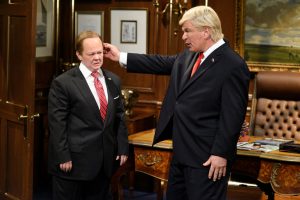
McCarthy and Baldwin as Spicer and Trump in parody on SNL. Photo credit: Will Heath/NBC.
Satire provides a more serious critique. In our class discussion we defined it as the use of humor, irony, exaggeration, or ridicule to expose and criticize people’s stupidity or vices, particularly in the context of contemporary politics and it comes with a bit more of a biting response than parody. Satire often tries to change society or politics, using laughter as a weapon, not as an end goal, and yet its efficacy depends on the audience recognizing irony. When the audience does not recognize the irony its impact is lost, such as the classic example of the reading public, or at least some of them, not understanding that Jonathan Swift’s essay, A Modest Proposal, which proposed the Irish poor sell their children to the English as food for the rich, was actually meant as an ironic insight into English policies at the time that had devastating effects on poor Irish families.
Irony, in many ways has become the dominant strand of satire in today’s postmodern, even post truth, world. It is exemplified by John Stewart’s approach on the Daily Show, and taken to an even more ironic level by Stephen Colbert. Irony, often misunderstood, is defined by Merriam-Webster’s as “a pretense of ignorance and of willingness to learn from another assumed in order to make the other’s false conceptions conspicuous by adroit questioning —called also Socratic irony…[or] incongruity between the actual result of a sequence of events and the normal or expected result.”
However, Lisa Colletta, in a 2009 essay digs deeper into the concept of irony, exposing a variant “postmodern irony” of which she says it “denies a difference b/t what is real and what is appearance and even embraces incoherence and lack of meaning.” She claims that postmodern irony is characterized by (A) self-referentiality and (B) cynical knowingness. Yet “a postmodern audience is made conscious of constructed nature of meaning and of it own participation in the appearance of things, which results in the self-referential irony that characterizes most of our cultural output today.” Perhaps the most classic example is Colbert roasting of President Bush at the 2006 White House Correspondents dinner, which in the words of Nelson from The Simpsons deserves a hearty: “Ha Ha.”

Stephen Colbert roasting President Bush at the White House Correspondents’ Dinner in 2006. Bush does not look very happy. Photo Credit: REUTERS/Hyungwon Kang – RTR1CXOV.
All is not a laughing matter though as Colletta points out that any efficacy of irony in today’s media landscape may not be very effective because the audience may not “get it” or it might lead people towards less engagement with politics. In fact, postmodern politics says that it does not matter who is in power as “choice is really between fakes.” The ironic, sophisticated voter is encouraged to let the powerful rule or “appear gullible” (Colletta 2009, p. 858). In our class we further discussed these issues, focusing on whether or not millennial voters lack of turnout has something to do with postmodernity and a feeling of a lack of efficacy even when engaging in the political process.
Again cause and effect is difficult to disentangle here, yet in the end Colletta, and also yours truly, believe that satire can be an important intellectual endeavor that can lead to political action. Colletta summarizes, from satire “we may be forced to see things in a new way and to acknowledge alternative possibilities. This, in turn, could make viewers more tolerant of those who approach things differently, and thus inspire them to action they have not yet considered” (p. 872). Perhaps we can even see evidence of people wanting to see things in a “new way” and to be inspired as many viewers of late night TV switched from Jimmy Fallon over to Stephen Colbert since Fallon infamously “humanized” Trump while Colbert kept pushing the political envelope in a time of national political upheaval.
Towards the end of the lesson I pointed out that unconventional political participation, in the form of comedic actions against rights abuses, actually has a long history. There have been many evocative actions taken that have exposed the irony of rights denying. For instance, the website New Tactics in Human Rights collects info on many cases from around the world of comedic actions. Another NGO, Information Activism, points out 10 approaches to “Exposing the Ridiculous” that can help promote change. One of my favorite examples was the Dole Army hoax in Melbourne Australia, where young people tricked the local TV stations to air segments about a made up army of unemployed people living under the city, on the dole (i.e. welfare in the U.S.), who planned on never working. This action easily, and hilariously, exposed the gullibility of the mainstream media to fall for a literally trumped up narrative against providing economic rights. Closing my lesson from today’s milieu surrounding comedy was Michael Moore’s 10 point call to action against Trump’s policies in the Huffington Post (2/24/17) which concludes with asking people to “JOIN THE ARMY OF COMEDY: Trump’s Achilles heel is his massively thin skin. He can’t take mockery. So we all need to MOCK HIM UP! Not just the brilliant people at SNL or Colbert, Seth Meyers or Samantha Bee ― but YOU. Use your sense of humor and share it with people. Get them to do the same.” And Moore is right, there is little doubt this is the thinnest-skinned U.S. president of all time.
Surely, it is hard to quantify if meaningful impacts will or have occurred from naming and shaming rights abusers through comedic actions and satire. However, what is clear is that turning to satire in times of darkness speaks to the depth, and resilience of the human spirit, and also underscores our ability to critique the powerful in innovative ways. In fact, I would argue that various comedic actions are an intriguing response with more intellectual, teaching, and real world power than one would initially suppose. At the end of the semester I asked students what topics should be kept in the class for next semester and they made it clear I better keep the satire class. Although some claimed Dr. Stranglove was a bit dated, and I kind of agree, yet it was irresistible to show such an innovative film. If anyone is aware of potential modern replacement films with an equally satirical bite feel free to send recommendations my way. In the meantime, who knows what will happen with modern U.S. politics and our rights, yet I urge the watching/support of media that allows us to laugh at events as it might be better for us psychologically than crying in the corner. And you never know it might lead one to participate in some “comedic actions” in the name of human rights.
Jack J. Barry, Ph.D., Postdoctoral Fellow, Global Training and Development Institute, University of Connecticut, email: jack.barry@uconn.edu
PS: I welcome comments on experiences, the good the bad, and the ugly, on using humor in the classroom—no dad jokes allowed though.
Sources not hyperlinked above: Colletta, Lisa (2009). Political Satire and Postmodern Irony in the Age of Stephen Colbert and Jon Stewart, The Journal of Popular Culture, Vol. 42, No. 5.
